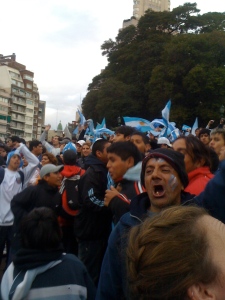CÓRDOBA, Argentina — Running and walking are terrific ways to get to know a place. The ground-level approach allows for the assimilation of sights and sounds into one’s impression of a city or region. I’ve had a few unique running-based experiences these past few weeks that stood out and I thought I’d share two of them.
Tucumán, Argentina. Tucumán, located in northwestern Argentina, is one of the country’s more forlorn provinces. Sure, the statistics will tell you as much — per capita GDP, unemployment, blah, blah, blah. But so does an experience I had while running the perimeter of the central park of the province’s eponymous capital.
Runners, at least the ones I know, are renowned for peeing in public places — after all, nature is not a call one lets go unanswered. To their credit, however, they generally take pride in discreetness. But the runners from Tucumán, or at least one runner from Tucumán, are in an entirely different league when it comes to audacity for public urination.
One evening a guy running in front of me abruptly stopped, directed himself towards a tree adjacent the sidewalk, dropped trou, lost some water weight, and returned to his workout without so much a glance at the passing rush-hour traffic on one of the heaviest used thoroughfares in Argentina’s fifth biggest city. From the reaction, or lack thereof, of perambulating passers-by, using public parks as a very public toilet is just as normal as the odor that wafts from Tucumán’s public waterways (perhaps not unrelated), the litter on the street, or the countless poor who traverse the city in horse-drawn carts scavenging for recyclables.
Fiambalá, Argentina. Fiambalá is ground zero for organizing this little mountain-measuring excursion into the mountains. It’s a modest pueblito at “the end of the world,” as its residents like to say. It feels the part. Surrounded by desert and near-constantly assailed by howling, sand-laden winds, Fiambalá nonetheless manages to take advantage of its location.
There are two attractions: hot springs and the Andean cordillera. I was there for the latter, but one night I ventured on a run to the former. After departing just a few kilometers beyond the town limits I was stopped in my tracks by the visually arresting clarity of the night sky. When in this part of the world last (two years ago) I made a similar observation in my journal — it is rather hard not to notice. Neither has this escaped the attention of the international astronomical community, which has sited the highest density of high-performance telescopes in the world in the Chilean-Argentinean altiplano region which Fiambalá abuts.
Looking into the sky, I practically felt my own eyes were telescopes. It was all there. The celestial dust of galaxy smeared from horizon to horizon in one shimmering longitudinal stripe, a fallow-yellow crescent moon, and a twinkling firmament stars everywhere else. When the night sky is this clear, this unadulterated, it’s the best show there is.
As fortune had it, the night sky was not the only entertainment on the evening. After reaching the hot springs I took a break to enjoy the lesser twinkling cluster of lights of Fiambalá in the valley below, and of course the greater twinkling mass of lights above. That’s when the guardrails on the side of the road started rattling. Earthquake!
Aftershocks still echo in this part of the Andes from the catastrophic 8.8 Chilean earthquake of late February. Whether this comparatively quaint 5.3 was an aftershock I am unsure, but it was a fun ride and an impressive second act to the sublime display of natural beauty and power to which I was fortunate to bear witness. Fiambalá may seem to be the end of the human world, but it one of the final, increasingly scarce frontiers to the truly natural world as well.




